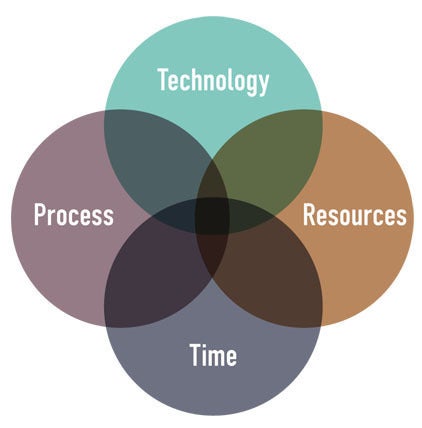
I was recently chatting with George Chiu, the director of the global technology group of Prudential Financial, about the technology we used at the beginning of our careers. We both rode the early 2000s tech wave when companies looked to technology to provide a competitive edge. Technology was thought to be the answer to all problems — the core problems often went unexamined with the hope that a quick tech fix would solve everything. Our conversation inspired this month’s column, which focuses on how attitudes toward technology have evolved over the last two decades.
More recently, the mindset has changed. Significant effort is placed on understanding driving needs and evaluating processes. Technologists used to be primarily viewed as nerds who were ensconced in a world of their own, complete with tech lingo that was impenetrable to non-techies. Now, the IT team is expected to help break down customer needs and translate those needs to process changes that can be supported by technology.
“It is easy to throw technology at a problem, but many times the newest, fastest, and ‘best’ technology is not what the business needs or wants,” Chiu told me. “It is a balancing act to identify what works, what the business needs, and the type of technology that fits the business process. There will always be ‘new technology,’ but are these potential consumers of said ‘new technology’ ready to use it?”
Drivers of change may nudge teams in one direction, but teams should not be shortsighted about what is really required. Here’s an example: A five-year-old app is now becoming a security risk because the servers cannot be patched any longer. This feels like a technology upgrade project, right? The IT team would simply upgrade the tech. But before your team upgrades the old technology, step back and evaluate the situation. Does the need for that original product or service still exist? Have the needs evolved? Is the upgraded version of the out-of-date application the best long-term solution? Or is there an alternative technology solution available? Could processes be changed so the technology is not needed any longer? Could processes be consolidated into a different existing application?

The directive you are faced with should also affect your approach. If your goal is to reduce overhead or operations and maintenance costs, then a one-time investment in technology, coupled with significant process changes, may provide cost-savings in the long term. If you have significant operations changes, you should assess technology and processes.
There are multiple approaches that can be taken to implement change, but the wrong combination can lead to high expenditures (expensive application purchase, significant investments in customization of the application to fit needs, or both) with low user adoption (if people do not use the solution put in place, you have a broken process where business and user needs are not being met). Which approach does your business use?
- Buy tech first and then force current process into tech →→ Tech wins, not actual business process flow
- Customizations
- Low user adoption
- No change of processes and procedures
- $$$$
- Medium time to implement but user change requests will drag on for months/years
- Buy tech first and then change processes to fit →→ Tech leads
- Customizations
- Low user adoption
- Some process change but it is limited to tech available
- $$$
- Medium time to implement but user change requests will drag on for months/years
- Change process with no new technology →→ Process leads but change is limited
- Customizations
- Possible to do without incurring cost
- Potentially low user adoption due to lack of efficiencies and effectiveness of process
- $
- Short time to implement
- Evaluate process first, find best tech fit →→ Process leads and improvement potential is unlimited
- Highest user adoption
- Advancing the department with new efficient processes
- Industry best practice
- $$
- Potentially the longest time to implement
Properly breaking down processes and identifying customer needs is an art. There are entire career paths for the practice of efficiently breaking down processes to establish customer needs and solutions, as well as a host of different methodologies, such as design thinking. When taking on the task of processes evaluation, use established resources to facilitate your effort.
Toward the end of our conversation, Chiu said that success comes down to clear communication: “At the end of the day, business and technology organizations need to partner to establish a consistent cadence for evaluating business process and available technology stack in order to determine the right direction to take to secure competitive advantage.” I completely agree.




